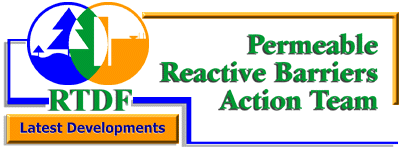 |
||||||||
|
|
|
|||||||
 |
||||||||
|
|
|
|||||||
![]()
![]()
|
The Permeable Reactive Barrier A permeable reactive barrier is a passive in situ treatment zone of reactive material that degrades or immobilizes contaminants as ground water comes in contact with it. Permeable treatment walls are installed as permanent, semi-permanent, or replaceable units across the flow path of a contaminant plume. Natural gradients transport contaminants through strategically placed treatment media. The media degrade, sorb, precipitate, or remove chlorinated solvents, metals, radionuclides, and other pollutants. These barriers may contain reactants for degrading volatile organics, chelators for immobilizing metals, nutrients and oxygen for microorganisms to enhance bioremedi tion, or other agents. Degradation barriers facilitate reactions that break down contaminants into harmless byproducts. Precipitation barriers react with contaminants to form insoluble products that remain in the barrier. Sorption barriers adsorb or chelate contaminants.
The mission of the Permeable Reactive Barriers Action Team is to accelerate the development of cost-effective permeable barrier technologies. The Action Team undertakes development and evaluation efforts needed to achieve public and regulatory acceptance of this technology. The efforts focus on:
Action Team members assisted with the design of the U.S. Air Force study, entitled "Catalytic In Situ Treatment of Chlorinated Solvents," and field work for the pilot-scale demonstration at the Area 5 site, Dover Air Force Base, Delaware. The Action Team also is actively involved in research and technology evaluation activities at the U.S. Coast Guard (USCG) site near Elizabeth City, North Carolina. The Action Team, in cooperation with EPA's Office of Research and Development, published "Permeable Reactive Barrier Technologies for Contaminant Remediation" in 1998. The document provides information on permeable reactive barrier (PRB) technologies. The document is available on the Team's home page on the RTDF World Wide Web site. Also in 1998 and updated in 2003, the Action Team prepared a status report on the use of permeable reactive barriers (PRBs) for ground-water remediation in the United States, Canada, and Europe. The report, available on the Team's home page on the RTDF Web site, includes profiles of about 40 ongoing and completed pilot- and full-scale PRB demonstrations and full-scale installations and a searchable bibliography of PRB-related articles and publications. The Action Team, in partnership with the Interstate Technology Regulatory Council (ITRC) Permeable Barriers Working Group, has developed a training course and manual to assist regulatory professionals in overseeing the design, implementation, and monitoring of ground-water remedies that involve the deployment of permeable reactive barriers (PRBs). The course was offered in each EPA Region in 1999 and 2000. The Action Team's Steering Committee launched a coordinated research effort in 1998 focusing on the long-term performance of PRB's (i.e. how long will they work), the major issue restricting further acceptance and deployment of this technology. The project involved the use of common techniques and monitoring approaches at selected PRB sites, collection and sharing of comparable data about PRB performance at each site over time, and development of peer-reviewed final reports on project milestones. The final report is now available on the Team's home page on the RTDF Web site.
The Action Team currently has plans to conduct a field pilot test for arsenic removal with zero-valent iron and the use of zero-valent iron to treat DNAPL source zones.
Would You Like More Information? For more information on the Permeable Reactive Barriers Action Team, please contact the Team Co-chairs: Bob Puls, Ph.D. John Vidumsky
|